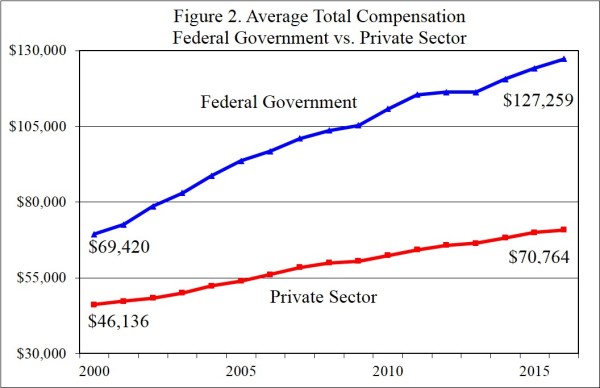President Trump has proposed a one-year pay freeze for federal bureaucrats, which has reinvigorated the debate over whether compensation levels for the civil service are too lavish.
The Washington Post opines this is nothing but “government bashing,” but this chart from my former colleague Chris Edwards should be more than enough evidence to show that federal bureaucrats have a big advantage over workers in the economy’s productive sector.

And there is plenty of additional evidence that federal employment is very attractive. For instance, it’s just about impossible to get fired from a bureaucracy.
Though defenders of the civil service sometimes make the preposterous claim that nobody gets fired because bureaucrats are such good employees.
The low rate at which federal employees are fired for poor performance doesn’t prove the government accepts it but instead “could actually be a positive sign,”… A report from the Merit Systems Protection Board in effect responds to members of Congress
and others who contend that federal managers don’t care, or don’t dare, to take disciplinary action because of civil service protections. “…If the agency is successful in preventing poor performance…, a small number of performance-based removals could actually be a positive sign,” MSPB said. …Of the 2.1 million federal employees in a government database…, about 10,000 are fired for either poor performance or misconduct each year. …That low rate of firing has been cited in proposals to force agencies to take action… Individual employees, too, commonly express dissatisfaction with how agencies handle poor performers among their co-workers.
I have to confess that my jaw dropped when I read this article. Maybe we should ask veterans whether they think all federal bureaucrats do a good job?
Or we can ask non-profit groups whether they think IRS bureaucrats are top-quality workers? Or ask anyone who has ever tried to navigate the federal government?
We also know that the counties where most federal bureaucrats reside are now the richest region of the entire nation.
The three richest counties in the United States with populations of 65,000 or more, when measured by their 2016 median household incomes,
were all suburbs of Washington, D.C., according to data released today by the Census Bureau. Eight of the 20 wealthiest counties with populations of 65,000 or more were also suburbs of Washington, D.C.–as were 10 of the top 25. …With Falls Church City included in the 2015 data, the nation’s four wealthiest counties were D.C. suburbs.
To be fair, this data is also driven by all the high-paid lobbyists. contracts, consultants, and others who have their snouts buried in the federal trough. So the incredible wealth of the DC region is really an argument for shrinking the size and scope of the federal government.
But the bureaucracy is part of the problem.
Interestingly, even the Congressional Budget Office concluded that bureaucrats are overpaid. And CBO almost certainly understated the gap, as noted in congressional testimony.
The CBO report’s headline figure is that, on average, federal salaries and benefits are 17 percent above private-sector levels. … I would consider the CBO’s reported federal compensation premium to be on the low end… when I analyze federal employee wages using the methodology
that the progressive-leaning Economic Policy Institute has used in numerous studies of state and local government salaries, I find an average federal salary premium of not 2 percent but of about 14 percent. … The CBO chose to value federal employees’ pension benefits using a 5 percent discount rate. Using that discount rate, the federal employee retirement package was found to be substantially more generous than is received by comparable private-sector employees. But…corporate pensions are not nearly as safe as federal pensions, as witnessed by pending benefit reductions for “multiemployer” defined benefit plans. Valuing federal pension benefits using a lower discount rate to better reflect their safety would find a higher overall federal compensation premium.
Notwithstanding all this evidence, the unions representing bureaucrats nonetheless try to crank out numbers showing federal employees are underpaid.
To be sure, overall compensation levels don’t tell us everything. It is important to adjust for education, skills, and other factors.
Which is why the most useful, powerful, and revealing data in this debate is produced by the Bureau of Labor Statistics, which measures voluntary quit rates by industry. If there is a lot of turnover in a sector of the economy, that suggests workers are underpaid. But if there are very few voluntary departures, that suggests workers in that part of the economy are overpaid.
And the numbers from BLS clearly show that federal bureaucrats are far less likely to leave their positions when compared to employees in the private sector.
This five-fold gap is staggering. I have lots of friends who work for the federal government. Most privately confess that they know that are making out like bandits. I think I’ll send this chart to the few holdouts.
By the way, I shared the numbers about quit rates for state and local bureaucrats back in 2011. Same story, though the compensation gap isn’t quite as large and may be driven mostly by unfunded fringe benefits.
P.S. I’m much more interested in shrinking government rather than shrinking pay levels. The correct pay for bureaucrats at the Departments of Transportation, Housing and Urban Development, Education, Energy, and Agriculture is zero. Why? Because they bureaucracies shouldn’t exist.


